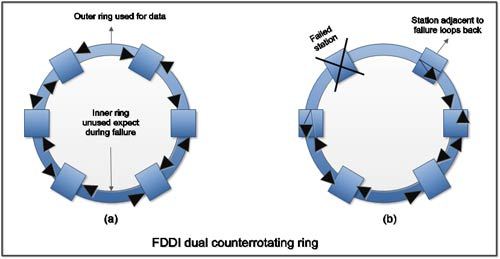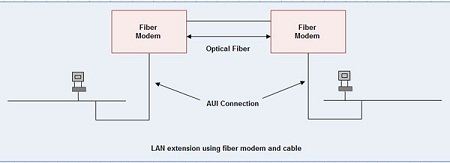Due its outstanding performance characteristics, fiber-optic cable is also used in LAN s. FDD I (Fiber Distributed Data Interface) is the current LAN standard (IEEE and ANSI) for such a network. FDDI can be extended to the desktop, either directly or through the use of twisted pair in a CDDI application.
- FDDI is the standard (ANSIX3T9-5; IEEE 802.2) for a fiber optic, token-passing ring LAN
- High bandwidth – 100 Mbps with full duplex interfaces
- Excellent error performance in the range of 10 -14
- Fiber is capable of transmitting data over very long distances
- Separation for multimode fiber can be as much as 1.2 miles (2 kilometers)
- 37.2 miles (62 kilometers) over single mode fiber
- Excellent security
- The maximum frame size is 4500B capable of accommodating the native frame sizes of all standard LAN networks
- High costs of acquisition, deployment, and reconfiguration
- Fiber also is very fragile; therefore it must be protected carefully.
The fragility of the fiber is a deterrent to the application of FDDI, as well. The FDDI specifications provide for a dual counter-rotating ring, which provides a measure of redundancy. If the primary ring fails, a Dual Attached Station (DAS) or Dual Attached Concentrator (DAC) can still communicate with any other device by transmitting in the opposite direction through the secondary ring, which typically is collocated in the same cable sheath as the primary ring.
 Fiber Optic Extensions
Fiber Optic Extensions
Fiber is very flexible in nature and provides less attenuation and good immunity to noise. Optical fiber with fiber modem is used to extend a LAN beyond its limit. The concept of fiber modem to extend an Ethernet connection. A fiber modem is inserted between AUI and fiber optic cable /at both the segments of Ethernet. This AUI connection may come directly from computer or transceiver depending upon the type of wiring being used. Fiber modems perform the conversion AUI signal to digital representation and light pulses, which can be sent along the fiber optic cable and vice versa. This mechanism can operate effectively for several kilometers. They are used widely to connect computers located in different buildings.

 Dinesh Thakur holds an B.C.A, MCDBA, MCSD certifications. Dinesh authors the hugely popular
Dinesh Thakur holds an B.C.A, MCDBA, MCSD certifications. Dinesh authors the hugely popular